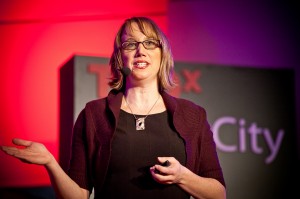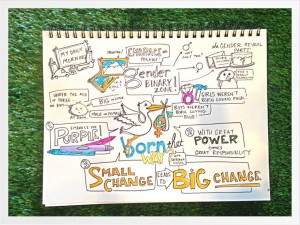 Let’s face it. It’s hard not to jump on the gratitude wagon this time of year. Research, we know, supports it. But research aside, I’m feeling it. And thought I’d share.
Let’s face it. It’s hard not to jump on the gratitude wagon this time of year. Research, we know, supports it. But research aside, I’m feeling it. And thought I’d share.
Between latkes and turkey leftovers, please join me in a collective shout out to ten feminist thought leaders in our midst. They are PhDs, soon-to-be PhDs, and/or serious mavens, all with a keen eye for popular debate, and they’re the current crew of active bloggers here on Girl w/Pen. Check out their latest, read all about them, and post a note here or at my FB page about who you’re feeling particularly grateful for in this realm. I’m always searching for models of thoughtful thought leaders, particularly in the zone of feminist public conversation. And additionally, we are always happy to induct new Penners into our crew.
So here we go. For their mind-bending, evidence-based, eloquent, witty, and pithy feminist dazzlery, I’m thankful for:
Veronica Arreola, who is currently pursuing her Ph.D., directs an academic support program for women majoring in STEM and is a longtime mover and shaker in the Chicago feminist community and nationally. Veronica taught me how to blog and is now my terrific colleague in my new hometown, where we frequently find ourselves sharing a stage. Veronica pens Science Grrl, a column exploring the latest research and press on girls and women in science & engineering.
Susan Bailey, who served as Executive Director of the Wellesley Centers for Women (WCW) and a Professor of Women’s & Gender Studies and Education at Wellesley College for 25 years, and as principal author of the 1992 AAUW Report: How Schools Shortchange Girls, is a thought leader whose insights fostered national public dialog on gender in K-12 education and someone I’ve long admired. She pens the column Second Look, offering her reflections of where we’ve been and where we need to go. Take a second look with her at the work unfinished in the realm of girls and sports.
Kyla Bender-Baird, author of Transgender Employment Experiences: Gendered Perceptions and the Law, is a Ph.D. student in Sociology at the CUNY Graduate Center and GWP’s fearless Managing Editor. Kyla pens The Next Generation, a column featuring young feminists under the age of 30 who are not yet established in an academic career. Kyla and I met when she was my intern at the National Council for Research on Women—and now, like so many former interns, I learn from her.
Tristan Bridges, an Assistant Professor of Sociology at The College at Brockport, State University of New York, book review editor at Men & Masculinities, and editorial board member of both Gender & Society and Men & Masculinities, pens the column Many Musings, with CJ Pascoe, an Assistant Professor of Sociology at the University of Oregon, and chair of the American Sociological Associations section on Sex and Gender. Together, they share thoughts on masculinity, inequality, and everyday life. They’re our newest addition, and I’m beyond grateful to have them with us. Check out their recent post on bro-porn (think: naked rowers) and the heterosexualization of straight men’s anti-homophobia.
Heather Hewett, who writes about women, feminism, and culture in the U.S. and globally for both academic and mainstream publications (including The Washington Post, CNN.com, The Christian Science Monitor, Brain, Child, and The Motherlode at the New York Times) and numerous anthologies, is an Associate Professor at SUNY New Paltz and a dear old friend without whom I would have probably given up writing a long time ago. Heather pens the Women Across Borders column, offering us a transnational perspective on women and girls. Read what she has to say about the complications, and the promise, of the global girls movement, and what she did on the International Day of the Girl this year.
Elline Lipkin, a scholar, poet, and nonfiction writer who has also worked as an editor for a variety of newspapers, magazines, and journals, is a girls’ studies guru who explores the state of contemporary girlhood in the United States and how gender is imprinted from birth forward. Her book, Girls Studies, is a guidepost in the field. She pens the Off the Shelf column, offering book reviews and news, and more. Read her latest (and we mean latest) on the GoldieBlox controversy.
Dara Persis Murray, who writes about the intersections of beauty and feminism as they occur online and in consumer culture (branding campaigns, advertisements, television programs) and whose work has appeared in the academic journals Feminist Media Studies and Celebrity Studies, and in edited collections, pens the Mediating Beauty column, where she muses on the intersections of beauty and feminism as they appear in consumer culture and digital culture. Dara and I met when she was my intern at the National Council for Research on Women; she then became my research assistant, and now I, too, learn from her. Read Dara’s take on Miley’s embrace of the f-word.
Adina Nack, who has been researching and writing about health, sexuality and stigma since 1994 (and winning myriad awards as she goes!), is author of the book Damaged Goods? Women Living with Incurable STDs and has covered topics including STD stigma, sex education, and HIV/AIDS in venues including Ms. Magazine, academic journalis, and anthologies. Adina is largely responsible for getting us over here to The Society Pages, where we are so happily at home. Adina pens Bedside Manners, in which she applies the sociological imagination to medical topics, with a special focus on sexual and reproductive health. Check out what Adina recently had to say about Miley Cyrus, sexuality, and her alma mater.
Virginia Rutter, who has been working at the intersection of academia and media for two decades: first in DC in Congress and at a mental health organization, and (during and after her PhD at the University of Washington), is a sociologist translating academic ideas to general audiences. The author of two books (The Gender of Sexuality and The Love Test, both with Pepper Schwartz) and numerous articles for Psychology Today, Virginia has written on topics including divorce, marriage, gender, sexuality, stepfamilies, adolescence, infidelity, depression, women in science, psychotherapy research, couples therapy, and domestic violence. Virginia is mentor and guiding light to many (including me). She pens the column Nice Work, sharing insights on social science in the real world.
Natalie Wilson, who is a literature and women’s studies scholar, blogger, and author who teaches at Cal State San Marcos and specializes in the areas of gender studies, feminism, feminist theory, militarism, body studies, contemporary literature, and popular culture. She is author of Seduced by Twilight and Theorizing Twilight and is currently co-authoring a book examining contemporary representations of zombies, witches, and ghosts in popular culture. She also regularly writes film reviews for Ms. Magazine and pens our Pop Goes Feminism column, where she ponders all things popular culture from a feminist perspective. Read her take on the feminist pull of Gravity.
I am also ridiculously grateful for GWP bloggers emeritus currently on hiatus or who have blogged with us in the past: Avory Faucette, Alison Piepmeier, Allison Kimmich, Gwendolyn Beetham, Shira Tarrant, Leslie Heywood, and others, who we welcome back anytime – once a Penner, always a Penner, they say.
Thank you, all, for sharing your minds, passions, and words–you all utterly make my day.
Follow Deborah on Twitter @deborahgirlwpen,“like” her page on Facebook, and subscribe to her quarterly newsletter to keep posted on workshops, offerings, writings, and talks.








